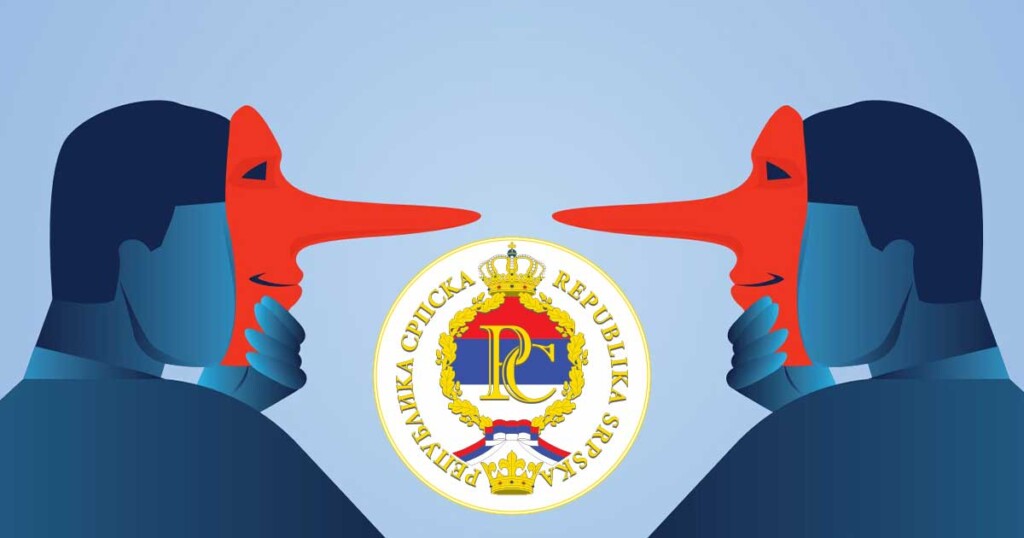They say that Christian Schmidt is self-proclaimed, unelected, illegal, and often even a false High Representative. If he falsely presents himself, then everything he says and does as High Representative is a lie as well. But then, everyone who treats him as if he is the actual High Representative – are liars too. Still, it’s a bit tricky even for Dodik to call Merz, Macron, and Starmer liars, although when it comes to the original Dayton Agreement, entity competencies, Bonn powers, the Prosecutor’s Office and the Court, the Constitution of Bosnia and Herzegovina, and much more – they lie shamelessly.
MARGINALIZATION OF TRUTH
They say we live in an era of post-truth. And since the opposite of truth is a lie, does that mean that today people lie more than ever before, and that truth has been marginalized like never before? Moreover, that everything has become a lie. Lies have, allegedly, intensified and escalated into all dimensions of life. We are lied to in advertisements, in the media, in business, in personal relationships – and especially in politics.
Although liars have always been met with moral condemnation, many still lied out of self-interest, to gain some form of advantage. But since that immoral tool was often used for material or other gains, in smaller communities such people would earn a bad reputation and no one would trust them anymore. However, in a new environment, there would always be enough naive people to believe them again. Classic liars are easy to catch if you recognize their self-serving motives.
They are harder to spot if such a specific interest, at least on the surface, doesn’t exist. Ivo Andrić writes about them: “They lie the way a dog barks, a rooster crows, a cow moos, a cat meows – out of some internal need unknown even to the liar himself.” Such aimless lying is considered in psychological and psychiatric literature as a disorder called Munchausen syndrome or pseudologia fantastica. However, a closer analysis shows that Andrić’s “internal need” is not merely a literary invention.
COLLECTIVE LIES
Unfulfilled ambitions for professional success, public importance, and social influence are often compensated by imagined involvement in significant events, fabricated ties to famous people, or invented compliments from supposed admirers. This mechanism can serve as a productive release from frustration and complexes, helping one regain internal balance—provided that the individual’s immersion in this imaginative fiction appears convincing to others. However, when the liar is exposed and ridiculed by their surroundings, they tend to react explosively. In any case, such lies are relatively harmless because they cause no damage to others, and as self-deception, they function to reduce the internal tension between aspiration and actual achievement.
An example of such an almost collective lie are the stories told by refugees in the 1990s about their supposed reputation and wealth back in their abandoned homeland. The feeling of humiliation caused by homelessness, social aid dependency, marginalization, and anonymity—especially in contrast to the locals in their new environment—was psychologically compensated by constructing narratives about what they once were and had in their former lives. They exaggerated what they left behind to their heart’s content, since the new environment had no way to verify it.
Lying can also take the form of simple exaggeration or distortion, whether through embellishment or vilification. According to Dvorniković and Cvijić, certain regional mentalities in the Yugoslav area are prone to extremes in perception and description of others. For example, a good person (honest, hardworking, virtuous, truth-loving, kind) is said to be “the best man in the village,” while a bad one is dismissed as “no kind of man at all,” meaning he has no good qualities whatsoever. Of course, truth is relative and comes in shades—good and bad traits are more or less evenly distributed, not concentrated in one person. The “most beautiful girl” in the village is simply attractive, or one of the more attractive girls—not literally the winner of a local beauty contest.

ORIENTAL KETMAN
Body language (blushing, scratching the ear, touching the nose) can reveal lying, but also a moral and psychological discomfort that, in a positive sense, shows the liar has at least preserved some internal critical distance from the lies they speak. However, body language can also be used to lie by skillfully concealing or controlling reactions: pretending to be ill to avoid an obligation, or in poker, pretending to have a stronger hand than you actually do to deceive your opponent.
Ketman is another form of lying, described by De Gobineau as the “Oriental ketman,” a specific practice of deceit in oriental despotisms—but one not foreign to European experience either. While a conformist passively and inarticulately adapts to something they internally disagree with—be it the majority, a trend, power, fashion, or similar—the ketman loudly and energetically supports what they secretly and deeply oppose. The lie of ketman is hidden even from one’s closest circle, and thus is hard to detect—until it eventually surfaces from the depths of the soul in a favorable moment.
ON HALF-TRUTHS AND HALF-LIES
A half-truth is the same as a half-lie, because the other half of the truth consists of a lie—and vice versa. Yet it is telling that we usually use the first term, and rarely the second, even though both describe the same thing. This is not like a half-empty or half-full glass. The emphasis on at least half the truth serves to push into the background the morally stigmatized concept of lying. It sounds very different to accuse someone in a debate of using “half-truths” rather than “half-lies,” because the latter implies the person is a half-liar.
Among ancient peoples in early societies, there was a blending of myth and reality, or at least a blurred line between what was real, possible, or merely desired. This must not be equated with the dichotomy of truth and lie, even though there are some similarities. Among the ancient Greeks, the overlap of myth and reality was a generator of creative imagination with great symbolic potential. They attributed human traits to their Olympian gods—even deceitfulness.
There is also such a thing as a noble lie. For instance, although in modern medicine there is a principle that even a hopeless diagnosis should be shared with the patient, many believe that one should not mentally destroy a patient by announcing a fatal outcome. On the contrary, it is better to give them hope and encouragement, because, according to modern medical science, this has therapeutic value and can even aid recovery.
Conscious lying, when repeated, becomes truth even for the ordinary liar. Just as the father of modern propaganda, Dr. Joseph Goebbels, stated that a lie told a hundred times becomes truth, repeated lying can cause even the liar to believe it—because the real truth is eventually forgotten. Does this mean the Nazis, spreading lies, eventually came to believe in them? Or did the genocidal plan for the Jews already exist earlier in Hitler’s Mein Kampf, written in prison? But then why did Goebbels call them lies that needed to be repeated 100 times?
HONEY AND MILK
Lying in politics is most obvious in modern election campaigns. While classical ideological parties once presented their platforms and tried to win voters over to their ideas, today’s parties do the opposite: they first conduct surveys on what the public wants to hear, and then incorporate that into their programs. That’s why promises of honey and milk differ only in shades. At the beginning of World War II, Churchill said: “I can offer you only blood, toil, tears and sweat!” — and that is still remembered and quoted precisely because it was an exception to the rule.
Imagine a party leader who, during a campaign, announced rising prices, falling wages, increased unemployment — and promised only to try to soften the blow. Who would vote for such a candidate, no matter how realistic the outlook might be? People prefer false promises and sweet lies to harsh truths. Which politician has ever stepped down mid-term, explaining that they failed to fulfill their promises? They’ll find a thousand excuses in unforeseen circumstances, mostly blaming objective difficulties, rarely admitting subjective shortcomings — and often pointing to external and internal enemies. Yet no one ever actually does nothing at all — so while their self-praise may be half-truths, the opposition’s total rejection of everything is usually spreading half-lies.

THE AGE OF POST-FACTS
Lies in wartime are considered strategic deception and a skill. And if, according to Clausewitz, peacetime politics is merely war by other means, then why shouldn’t lying also be seen as legitimate? Lying is eternal and takes many forms, but what has changed today? In the past, it was said: “He who lies also steals,” implying that the majority of people did neither. Today, however, honesty is highlighted only in rare individuals who stand out precisely because they don’t lie. In earlier times, lies were challenged with facts. But now, global media monopolies manufacture fake facts (fake news), whose credibility is directly proportional to the power behind them. So, we’re not living in a post-truth era — we are living in the age of post-facts.
By falsifying facts, a revision of history has been carried out—regarding, for example, the 100th anniversaries of both the First and now the Second World Wars. The revelations of WikiLeaks and Snowden’s disclosures of secret diplomatic cables have exposed many lies in international politics. And the only effective response to the spread of lies has become the distribution of counter-lies. In short, we live in a world of lies and paralies, as Sterija once put it. In these transitional times—from the fall to the rebuilding of the Berlin Wall—the very perspective of what is considered a lie is shifting.
THE SHATTERED MIRROR OF THE SIMULACRUM
Truth and lie are relational concepts. A lie is the negation of truth. But in order to know what a lie is, we first need to know what truth is. And do we really know what truth is? That, above all, leads us onto very slippery ground. The father of modern sociology, Auguste Comte, believed that the social world should be observed as a world of physical facts. However, truth can only be approached through an endless process of research and discovery, in which each stage of results can be considered a temporary, or relative, falsehood. It is well known that many of the greatest physicists were religious: when they made an epochal scientific breakthrough, they were confronted with new limits of knowledge and began to believe in a metaphysical creator of the universe. One answer would open up countless new questions. So what can be said then of the social sciences, which cannot uncover causal laws but only patterns of tendencies — that something might happen under certain conditions, and even that only with a high degree of probability? Kant wrote that we can know only the world as it appears to us through our limited cognitive capacities — not the world as it really is. “The thing-in-itself and the thing-for-us.”
The Frankfurt School of critical theory (Horkheimer, Adorno, Marcuse), drawing on the Hegelian-Marxist tradition, argued that the truth about society is not what currently exists, but what could exist — the better society that already exists in potential and must be recognized by the revolutionary mind and brought into reality. Postmodernists (Foucault), on the other hand, argue that truth, like lies, is a rationalist construct in which we — as modern people — only believe exists, and that scientific analysis cannot truly prove as fact. Instead, we live in a world of post-truth and post-facts, like a shattered mirror of the simulacrum.
FORCING INTO A LIE
Simply put, the boundaries between truth and lies have faded beyond recognition. In old democracies—now “democratorships”—the people are losing trust in political institutions and politicians. Voter turnout plummets, unprincipled coalitions come to power with minimal public support, while in the East, authoritarian charismarchs are rising. Yet, all of this happens within a single, unified capitalist system of production and reproduction of social life.
We are facing a global social condition in which media-driven political “truths” and lies are relativized, and it’s difficult to distinguish what’s real and what’s fake. Bombarded with a flood of contradictory information that constantly overtakes itself, people are disoriented, confused, and decapitated—unable to gather and piece together the fragments of a shattered worldview into a consistent whole. They crave change—any change—and are increasingly ready to embrace extreme ideologies and leaders. The deep state, the shadow rulers, the 300 families, the Club of Rome, Davos, the Bilderberg Group, the Trilateral Commission, BlackRock, and whatever else we call that small interest-driven elite, are on the verge of fulfilling Orwell’s dystopia. Bosnia and Herzegovina has become an experimental ground for the alchemy of turning lies into truth—and truth into lies.
Republika Srpska is the guinea pig, and Schmidt is the paradigmatic example of the modern liar. Once, the title of a popular American film “Liar Liar” became associated with former President Bill Clinton, who “humanely” bombed Republika Srpska under the code name “Deliberate Force”, and later did the same in Serbia and Montenegro under the cynical operation name “Merciful Angel.” Schmidt will, without a doubt—at least among the Serbs—become a lasting metaphor for deception, just as Dodik, if remembered for nothing else, will be known as the one who openly forced Schmidt and the Western neocolonial apparatus to face their own lies and called them by their true names.





